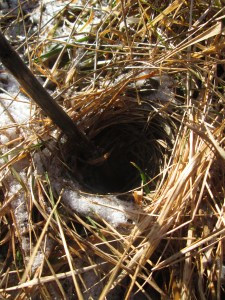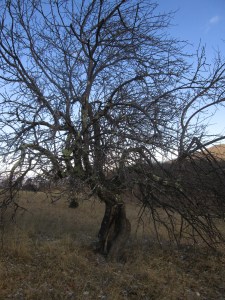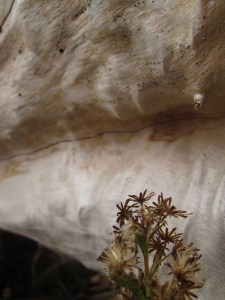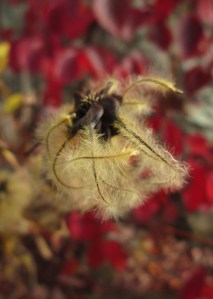circling up the rising thermals off the mountain’s ancient slopes,
the vertical frozen march of time’s looming flows, river deltas
hardened into stone ramparts, jagged edged, heating the air overhead
in the patchwork of gray and blue coming and going under the sun,
the vultures, color of the play of dark and light, rise and circle, circle,
metaphor and thing signified, they loop and loop, eyes
wide and bright and focused, the days and nights together flow
into knowledge, wisdom’s course in creatures of carrion,
bound in their gyres to the circle of making and remaking, life—
dying and eating, things final, forever, and always becoming.
to the black old trees they return in silent knowing communion,
unhooded and free, custodians of the dead, unsung and unsinging,
time’s arrow and time’s cycle both they bear, providential care,
they roost over the flooded valley bottom, and watch for winter’s end.
Category: Nature
a memento mori for the anthropocene
close your eyes and collect your heart,
feel the pricks and pains and discomforts of your body
the touch of your machine made clothes, smell far distant
the sweat of the Bangladeshi worker, straighten your spine,
breathe the heavy air. eyes now open,
direct your gaze at the concrete before you,
look for a breath and a half.
eyes shut, review the landscape in your heart:
sidewalk and building, road and powerlines, trees
rooted under the asphalt, straining. move the clock forward,
see the years pass, new oceans soon lapping at less distant shores,
the asphalt cracks, the sparrows take to the fields,
every edifice totters, o bring us the little foxes,
your body and your civilization a-mouldering in the grave,
tattered powerlines flying in the wind
rags tied at an unholy tomb.
these trees tumble, rot, and new trees grow,
the foxes remain but the vineyard is gone,
and muscadines tangle the new trees.
feel your bones and the built up bones of this world below
crumble to dust, taste the death dew heavy,
let your heart feel I and all my works will perish.
still the new trees grow
Ḥācım Sulṭān Fights a Dragon
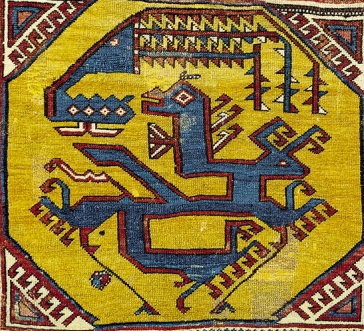
We’ve met Ḥācım Ṣultān before, so I will not give an introduction here, as the following account comes from the same late medieval into early modern hagiography translated in my previous post. This is one is a little different, however, both in subject matter- a battle with a mountaintop dragon!- and in its style, which I have tried to reproduce here as much as possible. Quite frankly, there are sections of this story that I do not fully understand, some of which it is possible the sixteenth century copyist did not fully understand either. The feeling of orality is very strong here, the core story- in which a mountaintop is broken into strange rock formations and colored red- sounding very much like an etiological tale in origin. The hagiography has done a couple of interesting things with the story: it is nested within a larger narrative in which rival dervishes and saints of Western Anatolia spar with and test Ḥācım Ṣultān, having just sent a man named Alaca Altu (‘one of the piebald horse’) to strike down the saint. Upon finding Ḥācım Ṣultān, Alaca Altu dismounted his horse, then
took his weapon in his hand. He gave a loud cry. He set out for Sulṭān Ḥācım. He struck but did not cut. Again he struck but he did not cut. A third time he struck but did not cut! Then the venerable Sulṭān Ḥācım said, ‘You must know, Alaca Atlu, your blade is not going to cut me. But mount your horse and so that you can come and fulfill my intention, upon that hill you ought to go and eat some food! When you ride up there let the dervishes cook you some kebab. We will not slice you up!’
The ‘hill’ becomes the focal point of the following story, which probably originally stood alone. After fighting the dragon, the hagiography continues beyond my translation, Alaca Atlu did indeed come up the mountain and eat some kebab with the dervishes and Ḥācım Ṣultān- a happy ending for everyone (except the dragon!). But before we think further about this tale, here it is, translated as best I could manage- with a stronger than usual caveat about the contingency of a translation.

Now then that mountain was very densely forested. A bird flying in could not fly out. Some people were dissimulatory towards Sulṭān Ḥācım, saying, ‘In the region of Menteşe he turned a woman into a man, in Germiyan he held up the water, and Alaca Altu could not kill him! Come, let us go and slay the dragon that has come into this forest,’ they said [to him]. Sulṭān Ḥācım entered the path. Upon the path the dragon manifest itself. Out of fear neither human nor jinn would draw close to it, however, one of those dissimulatory towards Muḥammad Muṣṭafā, upon whom be peace, out of coarseness said, ‘Master, you approach it!’ Now, in order to shame the hypocrites God revealed to his most pious and perfect Beloved suras and verses. Muḥammad Muṣṭafā recited [them], and the hypocrites were shamed and saddened. One came to the faith. He said, ‘Ya Muḥammad, if we had not treated you unkindly who would have known you to be a prophet?’ Now, then, it is likewise with God’s saintly servants, God having commanded concerning obligation towards them, saying, ‘Verily, there is no fear in the friends of God nor do are they saddened.’ The saints know one another’s states, though one who but accompanies the dervishes might deny [them]. They make sainthood manifest.
Now, then, Ḥācım Ṣultān approached the place of the dragon. Dervish Burhān followed behind him. Along the way, Dervish Burhān could hear a voice, and the smell of corruption was wafting along. All of his limbs went limp, and his reason was on the point of fleeing. Sulṭān Ḥācım said, ‘What is the matter Burhān?’ Dervish Burhān said, ‘My sulṭān, there is a bad smell coming from that forest! My reason is on the point of departing!’ Sulṭān Ḥācım said, ‘Let us walk forward. Alongside Seyyīd Ghāzī we drew the sword against the infidels and waged holy struggle while opening [to Islam] this place. At the time [this dragon] was a serpent akin to a creeping reptile. It seems that now it has become a dragon. Will it attack a human?’ Continue reading “Ḥācım Sulṭān Fights a Dragon”
The Spirit of Robinson Jeffers Rises Along the Lost River
Gray clouds mount, earth and river sink down
Under the stones’ still new cut. The sliced bloodroot bleeds and bleeds,
But the ten thousand things fall silent along the bypassed highway.
Ah hawk, swooped and spun by a following raven,
There is no solace in what we think will be freedom, but only
Shadows and dreams chasing and chasing.
My skin laps the bloodroot’s flow and the limestone opens
To staunch the river’s run. So what is hidden is always coming out,
And returning to ground, the round and round of the world.
One name gives way to another. Time goes, and goes nowhere,
Goes everywhere. I lock eyes for a hanging moment with
The buzzard in silent glide. Somewhere the ten thousand things gather.
Untamed, Eucharist and Eschaton
Offer the light piercing and the springmorning clouds
Over the grey backboned ridgelines gathering into early bloom.
Offer the salttaste of the marsh receding under early summer’s
Thunderheads larger than our toilsome systems, looming.
Offer this stone rolled down from the mountains rising,
Worn to round in years and years of river rise and fall.
Offer the moments that are not contained, offer the wind wet and cold
Off the sprucetreed highlands. Savage and beautiful is closeness
To the sacred, what in the last decree cannot be controlled. In the end all
This worn anthropocene too must give way, sedimented back into the holy,
Soil and stone of the world, bright and becoming from the hand of the Father—
Eucharist rung out still from the trampled earth, so take up and sing in offering,
What is not yours is that for which you must most give thanks.
On Landscapes

The landscape has its own sound, an idiom, a dialect, a particular light and temperature and their changes with the seasons. The landscape is the median, the densest synthesis, the ordinary reality. Most people grow up not in countries or towns but in what occupies the middle ground between them: in landscapes. “We are the children of our landscape; it dictates behavior and even thought in the measure to which we are responsive to it. I can think of no better identification.” The landscape is the center, the focus of our lives, and so it is also what is most contentious, contested, embattled, and susceptible to myth-making and ideological construction. There are near-equivalent terms: region, scenery, homeland. The landscape is more important than the political-administrative district; it means more to us than the state, and its meanings reach deeper. People define themselves by the landscape in which they have their roots no less than by the nation whose citizens they are. That is why landscape paintings are not just depictions but our world en miniature: microcosms. Because the landscape designates a totality, the history of the landscape, and of the cultural landscape in particular, has come to stand for efforts to reunite divided and isolated disciplines, to recover the conviction that history can, and should be, narrated as an integral whole, as histoire totale. “Landscape” is a highly malleable term, but its core meaning is inalienable, whether we speak of ruined landscapes or the landscapes of memory, of human or urban landscapes. It always designates the cohesive form, the ensemble. All its various meanings are anchored in its primary signification, the physical landscape.
We walk or travel through landscapes. Their changing appearances and the distinctions that let us tell them apart reveal the richness of our world. The landscape is the consummate result of human labor and human genuis. It is the greatest work of art imaginable, the supreme human achievement, and when our endeavors in it come to grief, it is the greatest conceivable calamity. The landscape is the most solid substance in which man has ever wrought the objective reality of his existence—geography, Robert A. Dodgshon has written, is about the “materiality of social life”—and at once his subtlest and most atmospheric creation, to which poets, philosophers, architects, and the entire human community have each contributed their shares. So to read and decipher landscapes is to unlock a door to the history of a people, of the nations, of humanity. Because “virgin” landscapes do not—or not longer—exist, all history of the landscape is a history of cultural landscapes. Hugo Hassinger has argued that anthropogeography is simply the “morphology of the cultural landscape,” the study of the tectonics of the social sphere, the inertia of the built world, the visible distribution of power and powerlessness, to mention only a few aspects. Historians are experts in matters of cultural forms: (cultural) morphologists. They take an interest in surfaces, and so they must be good phenomenologists and physiognomists if they hope to detect essential processes. They read the landscape like a text, carefully peeling off layer upon layer as though it were a palimpsest.
Karl Schlögel, In Space We Read Time: On the History of Civilization and Geopolitics, translated by Gerrit Jackson (New York City: Bard Graduate Center, 2016), 235-237.
From Above the Frozen Potomac
We are standing on a flood-scoured tongue of rock that juts down from the banks of the Potomac River, a mile or so below the mouth of the river’s great gorge, a gorge headed by the mighty Great Falls. The cries of geese settling down into an open basin of water within the ice-choked river overwhelm the distant hum of the interstate. That hum is the only indication of how close we are to ‘civilization,’ and to the very seat of the American imperium. The sprawling organs of that state are but a few miles downstream, but here—here the broad river is silent under sheets of ice, melt-water pooling here and there as the temperature has risen a bit above freezing the last couple of days. Beneath the ice the river is strong, is pure power and energy, surging towards the sea. It bubbles up from under the ice in the oval basin where the geese have found refuge, and here and there in riffles and surges. I scan the sprawling sheets of ice, multicoloured, sinuous, maps to other worlds that intertwine with ours but will always lie out of our grasping reach. Near the river’s right bank—the Maryland side, though this is a designation that lies so lightly on the land, and will one day pass away—my eyes fall upon a scuttling, flapping black mass. A circle of black vultures, gathered around some victim of the river’s ice, stark and brilliant against the pale grays, blues, and whites. Overhead, a grey sky hangs heavy and cold, reaching down into the ghostly limbs of the sycamores that rise above the river’s banks, seeps into the ancient stone.
I shift upon the river-scoured stone, witness to the last great age of ice, when the decaying continental ice sheets unleashed world-shaking floods on this stretch of river, and cut across and down into the incredibly ancient metamorphic rock that jaggedly breaks upon the earth’s surface here. The cold rises up from the frozen river’s surface. I check to make sure my little son—tomorrow is his tenth month birthday—is warm, his face turned inwards to my chest, snuggled and asleep for now. Later, by the lively river rapids further down he will wake back up and take in the mighty beauty, but at the moment he sleeps against me, warm and peaceful. There are no other humans in sight from here. At points along the river, outside of the Park Service domains, mansions of the rich leer down, but from where we are standing they are invisible, cloaked by hill and stone and tree.
For a moment I think of the halls of power downstream. The river’s waters will flow past them soon, but they will pay the halls and the mighty men and women and the monuments and the sprawling buildings and high-rises no heed. I think: one day, perhaps soon, perhaps in the far distant future if the Eschaton tarries, the monuments will crumble, the detritus of empire will accumulate out in the Potomac’s outflow into the Chesapeake. The river will still be here. The ice will spread across the river, the vultures will gather and enact their age-old somber and joyous dance, turning death back into life. Perhaps the ravens and bears will have come down from the mountains by then, adding their gronks to the cold air, their tracks over the snow. The works of men will perish, thank God. There is a strange comfort in the thought, and comfort in our sharing in this moment and space of the wild, the sublime and the beautiful, so close to so much that is not beautiful, that is destructive and terrible and which lays waste to the earth, to the soul, to the good. I cannot dislodge the systems and powers downstream, and I do not love to think that my son will inherit a world marked by the same or similar ones. I do not know what the ecologies and landscapes that I love and that I hope he will love, too, will be like in ten or twenty years. But while nothing is certain, I am hopeful that places like this, moments like this, will remain, that one day he can stand above a frozen river in the depths of January, perhaps with a germ of memory of this very day, and breath in the wild, feel the charge of—yes—holiness, of the grandeur of God, and the impermanence of the works of man, good and bad, and listen to the silence of the ice, the faint rustle of the river oats, the power of the river in motion, and to be present in it.
September Beside the Potomac
Persimmon fruit hangs sweet and heavy in the air-
Bottomland forest along the Potomac,
First leaf falls whisp in and out, acorns, walnuts
Scatter and plop to the sandied floor, soundings.
Cool breeze washes the warm dense scent of the river
At end of summer up to us, promise of change. Memory’s scent,
Of my own late summer childhood nestling in
The sun-warmed receding pools, focusing the gentle force of drawn-
Down cascades in the Piney River, sniffing in the little river,
Shivering as the sun got low in afternoon
And we got out of the water. Now, my little son
Reaches out to feel the great round bole of a silver maple,
Smiling, two vigors, connecting. Together, we take in the
Touch, the forest and the river’s wafting multiplicities,
Such lines of continuity, untamed worlds, wild rivers,
Seasons in their turns and turns and turns.
Small Worlds, Nelson Sods, Winter
Straddling the long stony spine of West Virginia’s North Fork Mountain is an expanse of natural meadows, edged by red pine groves and gnarled oaks, called Nelson Sods (‘sods’ in local geographic usage means ‘meadows’). While the views are spectacular, the photos below, taken on a recent hike up on the mountain, are of the smaller wonders found there.
Above: wind-sculpted grasses along the ridgeline. Below: grass woven into a circular shape by the action of wind upon a milkweed stalk.
Above: a lone tree in the midst of the Sods. Below: a view across the ridge, red pines in the foreground.
Above: an old pine stump in the Sods. Below: detail of the weathered wood of the stump.
Below: British-soldier lichens.


